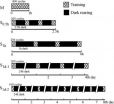First X-ray lasing of SACLA
Next-generation facility up and running with powerful new X-ray laser
2011-06-19
(Press-News.org) RIKEN and the Japan Synchrotron Radiation Research Institute (JASRI) have successfully produced a first beam of X-ray laser light with a wavelength of 1.2 Angstroms. This light was created using SACLA, a cutting-edge X-ray Free Electron Laser (XFEL) facility unveiled by RIKEN in February 2011 in Harima, Japan. SACLA (SPring-8 Angstrom Compact free electron LAser) opens a window into the structure of atoms and molecules at a level of detail never seen before.
The use of ultra high-intensity X-ray free electron laser light to explore the miniature structure of matter, until recently inconceivable, is today transforming how we visualize the atomic world. By providing much shorter wavelengths and higher intensities than other lasers, XFEL enables researchers to directly observe and manipulate objects on an unrivalled scale, opening new research opportunities in fields ranging from medicine and drug discovery to nanotechnology.
One of only two facilities in the world to offer this novel light source, SACLA has the capacity to deliver radiation one billion times brighter and with pulses one thousand times shorter than other existing X-ray sources. In late March, the facility marked its first milestone with beam acceleration to 8GeV and spontaneous X-rays of 0.8 Angstroms.
Only three months later, SACLA has marked a second milestone. On June 7, SACLA successfully increased the density of the electron beam by several hundred times and guided it with a precision of several micrometers to produce a bright X-ray laser with a wavelength of only 1.2 Angstroms (a photo energy of 10 keV). This matches the record of 1.2 Angstroms set at the only other operational XFEL facility in the world, the Linac Coherent Light Source (LCLS) in the United States.
With experiments soon to commence and user operations at the facility to begin by the end of fiscal 2011, this new record offers a taste of things to come with SACLA's powerful beam, the world's most advanced X-ray free electron laser.
INFORMATION:
The latest information will be updated on the website of SACLA: http://xfel.riken.jp/
END
ELSE PRESS RELEASES FROM THIS DATE:
2011-06-19
The potentially lasting implications of day-to-day couple conflict on physical and mental well-being are revealed in a study published today in the journal Personal Relationships.
Until now research has concentrated on the immediate effects of romantic conflict, typically in controlled laboratory settings. In one of the first studies to look at the longer term, Professor Angela Hicks investigated the physiological and emotional changes taking place in couples the day after conflict occurred, specifically taking into account the differing styles of emotional attachment ...
2011-06-19
Luiz Tadeu Moraes Figuedo's paper on dengue in Brazil confirms the country's worsening trend; from 1999-2009, where cases rose at 6.2% per year and dengue deaths at 12.0% per year.
Carmen Perez and co-workers, reporting on dengue vector control in Puerto Rico, found that 83% of the costs ($1.97 per person per year) were funded by the lowest and often the least financed level of government: municipalities.
Examining dengue cases imported into France, Guy LaRuche documented the alarming increase in cases originating from Cote d'Ivoire from only one case in 2006-07 to ...
2011-06-19
Negative-pressure wound therapy probably does not promote healing. This is the conclusion of Frank Peinemann and Stefan Sauerland's meta-analysis in the current edition of Deutsches Ärzteblatt International (Dtsch Arztebl Int 2011; 108[22]: 381-9).
In negative-pressure wound therapy (NPWT), wounds are covered with an airtight film and an adjustable negative pressure is applied using an electronically controlled pump. The negative pressure drains wound exudate and is thought to promote healing. This procedure is used in particular for chronic persistent wounds and complicated ...
2011-06-19
A University of Exeter biologist has discovered a 'lost' species of bat breeding on the Isles of Scilly (UK). A pregnant female brown long-eared bat is the first of its species to be found on the islands for at least 40 years. It was discovered by Dr Fiona Mathews, Senior Lecturer at the University of Exeter, a postgraduate student and a team from the Wiltshire Bat Group.
The Scilly Isles Bat Group called in Dr Mathews and her team to help them find out more about bats on the islands. The researchers set up a radiotracking study, with funding from the Isles of Scilly ...
2011-06-19
Researchers headed by Joan Massagué at Memorial Sloan-Kettering Cancer Center (MSKCC) in New York and by María Macías at the Institute for Research in Biomedicine (IRB Barcelona) have identified a complex mechanism by which some proteins that are essential for life, called Smads, regulate the activity of genes associated with cancer. The fruit of three years of intense work, the study reports on the life cycle of this protein, a process that ensures that the protein is destroyed when it has completed its function. These results have been published today in the top journal ...
2011-06-19
Scientists and educators alike have long known that cramming is not an effective way to remember things. With their latest findings, researchers at the RIKEN Brain Science Institute in Japan, studying eye movement response in trained mice, have elucidated the neurological mechanism explaining why this is so. Published in the Journal of Neuroscience, their results suggest that protein synthesis in the cerebellum plays a key role in memory consolidation, shedding light on the fundamental neurological processes governing how we remember.
The "spacing effect", first discovered ...
2011-06-19
A compound that for about 60 years has been used as a drug against tapeworm infection is also apparently effective against colon cancer metastasis, as studies using mice have now shown. The compound silences a gene that triggers the formation of metastases in colon cancer. Professor Ulrike Stein (Experimental and Clinical Research Center, a joint cooperation between the Charité Medical Faculty and the Max Delbrück Center for Molecular Medicine, (MDC)) and her research group made this discovery in collaboration with Professor Robert H. Shoemaker of the National Cancer Institute ...
2011-06-19
VIDEO:
A movie of the encounter made by combining 100 images of the June 1, 2011 Phobos–Jupiter conjunction. The High Resolution Stereo Camera on Mars Express took this sequence.
Click here for more information.
Earlier this month, ESA's Mars Express performed a special manoeuvre to observe an unusual alignment of Jupiter and the martian moon Phobos. The impressive images have now been processed into a movie of this rare event.
At the moment when Mars Express, Phobos, and ...
2011-06-19
The post-war trend of falling birth rates has been reversed across Europe, according to a new study. However, despite an increasing emphasis on family and fertility policies in Europe, this recent development involves social, cultural and economic factors more than individual policy interventions.
For some decades, couples have been having children later in life. But birth-rates among younger women have stabilised and the long-term trend towards lower fertility rates has been reversed.
Politicians are still left to grapple with problems associated with an ageing population ...
2011-06-19
It pays to prevent fractures. That's one of the main findings of a landmark report 'Osteoporosis – Burden, Healthcare provision and Opportunities in the European Union' newly published in the journal Archives of Osteoporosis. The study, compiled by the International Osteoporosis Foundation (IOF) in collaboration with the European Federation of the Pharmaceutical Industries and Associations (EFPIA), calculates the future burden of fractures as a consequence of increasing treatment uptake in the five largest European countries as well as Sweden.
Fragility fractures, which ...
LAST 30 PRESS RELEASES:
[Press-News.org] First X-ray lasing of SACLA
Next-generation facility up and running with powerful new X-ray laser

